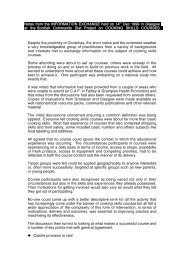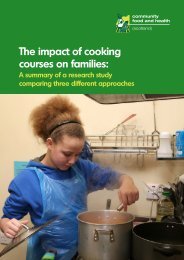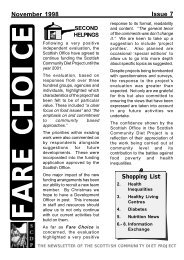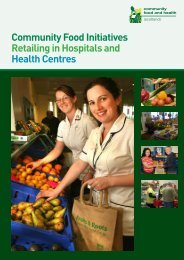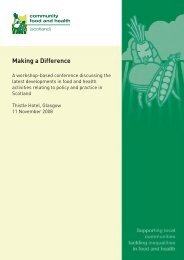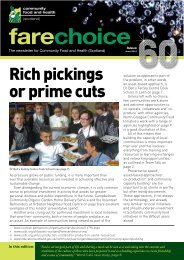Scottish Grocers Federation Healthy Living Pilot Evaluation
Scottish Grocers Federation Healthy Living Pilot Evaluation
Scottish Grocers Federation Healthy Living Pilot Evaluation
Create successful ePaper yourself
Turn your PDF publications into a flip-book with our unique Google optimized e-Paper software.
Prepared by:Proofed by:Quality Controlled by:EKOS Quality Assurance RecordName and emailRick Rijsdijkrick.rijsdijk@ekos.co.ukKevin Williamsonkevin.williamson@ekos.co.ukJonathan Coburnjonathan.coburn@ekos.co.ukDate26/08/200927/08/09200927/08/092009 As part of our green office policy all EKOS reports are printed double sided.
Contents1. Introduction and Background 12. Programme Objectives and Strategic Fit 43. Programme Performance 64. Case Studies 145. Comparative Assessment 346. Conclusions and Recommendations 36
1. Introduction and BackgroundThis report has been commissioned by Community Food and Health(Scotland) (CFHS) to conduct an evaluation of the Roll Out of the <strong>Scottish</strong><strong>Grocers</strong> <strong>Federation</strong> (SGF) <strong>Healthy</strong> <strong>Living</strong> Programme to Community FoodInitiatives (CFI’s) (‘the SGF Programme’ thereafter).This section sets out the background of the SGF Programme, and presentsthe study objectives and methods used.The research was conducted between September 2008 and July 2009.1.1 BackgroundThe <strong>Scottish</strong> <strong>Grocers</strong> <strong>Federation</strong>’s (SGF) <strong>Healthy</strong> <strong>Living</strong> Programme wasestablished in 2004 to improve people’s eating habits, particularly in lowincomeareas. It works with convenience stores, encouraging them toincrease the amount of fruit, vegetables and other healthier produce thatthey sell in their local communities. Around 500 stores across Scotland areinvolved in the programme which is part-funded by the <strong>Scottish</strong>Government.As part of their work to support community retailing, Community Food andHealth Scotland (CFHS) has established a pilot project to roll out, and testthe appropriateness of, the <strong>Healthy</strong> <strong>Living</strong> programme for community foodinitiatives and find out if the programme would have an impact on the CFI’simpact and long-term sustainability.The pilot programme included:• the delivery of seven SGF <strong>Healthy</strong> <strong>Living</strong> training sessions to staff andvolunteers working in community co-ops and community foodoutlets; and• the distribution and use of 27 sets of branded point-of-sale standsand display materials with the ‘<strong>Healthy</strong> <strong>Living</strong>’ message to CFI’s thathave taken part in the trainingThe pilot has supported CFI’s in three areas – East/Central Scotland,Aberdeen & Moray, Glasgow and Lanarkshire.<strong>Evaluation</strong> of the Roll Out of the SGF <strong>Healthy</strong> <strong>Living</strong> Programme to Community FoodInitiatives – Community Food and Health (Scotland)1
• semi-structured interviews with 3 key stakeholders, representingCommunity Food and Health (Scotland), the <strong>Scottish</strong> Governmentand the <strong>Scottish</strong> <strong>Grocers</strong> <strong>Federation</strong>;• a baseline questionnaire to all participants of the programme;• an evaluation questionnaire to all participants of the trainingsessions; and• site-visits to 11 of the participating projects.From this research, an assessment of the emerging impact, althoughtentative, has been undertaken.Finally, lessons learned and recommendations for the future were drawn.There are, however, a number of limitations to the scope and depth of thestudy:• baseline information is not retained by all participatingorganisations, and was partial; and• insufficient resources available to the research team to visit all siteswhere the materials were used.1.4 Structure of ReportThe remainder of this document is structured as follows:• Section 2 describes the programme objectives and the strategic fit;• Section 3 assesses the performance of the programme;• Section 4 describes the lessons learned from the site visits; and• Section 5 provides conclusions and recommendations.<strong>Evaluation</strong> of the Roll Out of the SGF <strong>Healthy</strong> <strong>Living</strong> Programme to Community FoodInitiatives – Community Food and Health (Scotland)3
2. Programme Objectives and Strategic FitThis section provides an overview of the SGF <strong>Healthy</strong> <strong>Living</strong> Programme pilotand its objectives. Section 2 further determines the project’s strategic fitwith policies and good practice across Scotland.2.1 Programme ObjectivesThe <strong>Scottish</strong> <strong>Grocers</strong> <strong>Federation</strong>’s <strong>Healthy</strong> <strong>Living</strong> programme was originally aprogramme aimed at convenience stores. Its purpose was to improvepeople’s diets, particularly in low-income areas. The idea is that if theprogramme supports local shopkeepers to better market and display freshfruit and vegetables and other healthier food, people will buy more of it andimprove their diets. The programme is especially targeted at areas ofdeprivation to reduce the existing health inequalities.Based on the success of the original SGF <strong>Healthy</strong> <strong>Living</strong> programme forconvenience stores, CFHS, with the support from the <strong>Scottish</strong> Government,set out to introduce the same benefits to CFI’s and have initiated a pilotproject to roll out the SGF <strong>Healthy</strong> <strong>Living</strong> Programme to CFI’s in three areasin Scotland: East/Central Scotland, Aberdeen & Moray, Glasgow andLanarkshireThe participating projects were offered support through the pilot project inthree ways:• access to a tailored SGF <strong>Healthy</strong> <strong>Living</strong> training session and a DVD tobe used as reference after the training;• the loan of a branded point-of-sale stand; and• display materials with the ‘<strong>Healthy</strong> <strong>Living</strong>’ message.The specific objective of the pilot project for CFI’s is:• to increase the turn-over of CFI’s and thus to contribute to their longtermsustainability by:o improving the quality of produce sold; ando increasing the marketing skills of staff and volunteers workingin the CFI’s<strong>Evaluation</strong> of the Roll Out of the SGF <strong>Healthy</strong> <strong>Living</strong> Programme to Community FoodInitiatives – Community Food and Health (Scotland)4
3. Programme PerformanceThis Section presents an overview of the activities, progress and reportedbenefits arising from the pilot programme. The findings presented in thissection are based on EKOS’ survey of training participants.3.1 Training Programme3.1.1 Overview of the TrainingThe pilot project delivered seven training events in Glasgow, Edinburgh,Stirling, Musselburgh, Peterhead, Bellshill and <strong>Living</strong>ston. In total the sevenevents were attended by 77 participants from 30 CFI’s.The training sessions lasted one day and were facilitated by Ross Kerr, theSGF <strong>Healthy</strong> <strong>Living</strong> Programme Co-ordinator. The training had the aim to:• promote the objectives of the SGF <strong>Healthy</strong> <strong>Living</strong> Programme;• improve the range of fruit and vegetables of CFI’s; and• improve the display of fresh fruit and vegetables by CFI’s.3.1.2 Immediate Post-Programme FeedbackImmediately following the training, EKOS distributed a questionnaire to allparticipants. Of the 77 participants, 31 returned the questionnaire, whichequates to a response rate of 40%.The respondents represented a broad spectrum of the community food andhealth sector, ranging from small food co-ops, entirely run by volunteers(opening once a week for a couple of hours) to large CFI’s run byprofessional staff (opening up to six days a week for more than 40 hours perweek). Table 3.1 and Table 3.2 show the opening days and opening hours ofthe respondents.<strong>Evaluation</strong> of the Roll Out of the SGF <strong>Healthy</strong> <strong>Living</strong> Programme to Community FoodInitiatives – Community Food and Health (Scotland)6
Table 3.1 number of opening days per weekOpening daysNumber of respondents1 day per week 11 (38%)2 days per week 2 (7%)3 days per week 3 (10%)4 days per week 05 days per week 8 (28%)6 days per week 5 (17%)Source: EKOS Training Survey, September 2008, based on 29 responsesTable 3.2 shows the average hours of operation per week.Opening hours per weekNumber of respondents0 - 4.5 hours per week 9 (31%)5 – 8 hours per week 5 (17%)9 – 16 hours per week 3 (10%)17 – 30 hours per week 2 (7%)31 – 40 hours per week 4 (14%)More than 40 hours per week 6 (21%)Source: EKOS Training Survey, September 2008, based on 29 responsesThe main reason for participants to attend the training was to improve themarketing/promotion of fresh fruit and vegetables and increase their sales.Many respondents also stated that they attended the training as part oftheir job or at the request of the CFI. Table 3.3 shows the reasonparticipants stated for attending the training session, thus stating theirexpectations.Table 3.3 Reasons for attending the training sessionsReason for attending trainingNumber of respondentsTo market/promote fruit/veg. better 8Part of the job/asked by CFI 8To increase our sales 5To increase knowledge of the retail sector 3To run our CFI better 2To get a free display stand 2To improve my skills 1To increase knowledge about storage 1Source: EKOS Training Survey, September 2008, based on 31 responses<strong>Evaluation</strong> of the Roll Out of the SGF <strong>Healthy</strong> <strong>Living</strong> Programme to Community FoodInitiatives – Community Food and Health (Scotland)7
Almost all participants expressed a positive opinion about the event; 58%(18 participants) thought it was very helpful, 39% (12 participants) thought itwas helpful and only 3% (1 participant) thought that the event was nothelpful. Table 3.4 shows what aspects of the training participants foundmost helpful.Table 3.4 What participants found most helpfulMost helpfulFrequency mentionedHow to display/promote fruit/veg. 11All of the training 4Information on storage of fruit/veg. 3Information on what products sell well 3Networking / sharing best practice 2Clear facilitation of the event 2Knowledge of fruit & veg. / waste reduction1/ the promotional materials (DVD) / linkbetween quality and sales / links with otheragencies / ideas for promotion / Info onpricing / how to increase sales / info onfunding / how to use the stallSource: EKOS Training Survey, September 2008, based on 31 responsesWhen asked what parts of the training were not helpful, four participantscommented that the training was too much geared to commercialconvenience stores and did not take into account the specific role of CFI’s ,and one participant was not involved in selling food.Of the 28 participants that responded to the question, 27 (96%) found thetraining and the commercial approach to distributing fruit and vegetablesappropriate for their CFI. One respondent (4%) thought this was notappropriate.Some respondents, however, commented on the commercial focus of thetraining and one respondent mentioned the lack of proper equipment toimplement the learning, such as fridges and displays.The participants found the content of the training relevant to theirorganisations and activities. On a scale from 1 – 5 the average relevance ofthe training content was 2.5, with 1 being very relevant and 5 not beingrelevant at all. All respondents found the length of the training just right.Table 3.5 describes what the participants though was the most importantsingle message from the training.<strong>Evaluation</strong> of the Roll Out of the SGF <strong>Healthy</strong> <strong>Living</strong> Programme to Community FoodInitiatives – Community Food and Health (Scotland)8
Table 3.5 Most important single message from the trainingMost important single messageFrequency mentionedImportance of display/presentation of fruit/veg. 16How to promote/market fruit/veg. 5Importance of quality of fruit/veg. 4How to get messages across to customers 2How to sell fruit/veg. 1Importance of profit for CFI’s 1Increase in government support for CFI’s 1Source: EKOS Training Survey, September 2008, based on 31 responsesWhen asked to comment on any ways in which the training had changedtheir way of thinking about their customers and the development of theirCFI, respondents reported:• an increased understanding of the importance of how fruit andvegetables are displayed/presented;• an increased ability to understand and meet customers need;• an understanding of the ability to better advertise and promote theCFI and its products;• an acknowledgement of the importance of choice and variety forcustomers; and• increased commercial thinkingFollowing the training the vast majority (92%) of the respondents thoughtthat their CFI has the skills, knowledge and capability to adopt a morecommercial approach to distributing fresh fruit and vegetables.There were a few other comments and suggestions relating to ways that thetraining might be improved:• regular updates/refreshers of the training would be useful;• the training could be more targeted at the voluntary community foodand health sector;• hands on follow-up support would increase the impact of thetraining;• there is a need for the planned display stand and promotionalmaterials; and<strong>Evaluation</strong> of the Roll Out of the SGF <strong>Healthy</strong> <strong>Living</strong> Programme to Community FoodInitiatives – Community Food and Health (Scotland)9
• for some CFI’s the venues in which they have to operate can hinderthe implementation of the training lessons.3.1.3 Stakeholder Perspectives on the TrainingThe interviewed stakeholders expressed a positive opinion on the training.The facilitator of the training programme, expressed that the trainingprogramme was a success and had reached its objectives. He noted theenthusiasm of the participants and their plans to implement what they havelearned. No concerns or issues were raised.The Policy Executive of the <strong>Scottish</strong> Government thought that the transfer ofsales and marketing skills from the commercial sector to the CFI’s wasimportant and could potentially contribute to the sustainability of the CFI’s.The Development Officer of CFHS, who attended some of the trainingsessions and who works with the CFI’s on a regular basis, thought that thetraining was well received by the CFI’s and has received anecdotal evidencethat some CFI’s have implemented what they have learned.3.1.4 Subsequent Feedback on the Impact of the TrainingEKOS also sent a separate questionnaire to all 16 CFI’s that received a standand promotional materials, in which questions were asked about thetraining. Of the 16 CFI’s 10 (63%) responded. The questionnaires werecompleted six months after the initial training sessions. Table 3.6 showshow the CFI’s have implemented what they have learned from the training.Table 3.6 Implementation of training by CFI’sActionFrequency mentionedImproved display/presentation of fruit/veg. 5Cascaded training information to volunteers/staff 3Developed the CFI 2Used existing resources better 1Improved pricing structure 1Improved stock rotation 1Improved promotion 1Better use of seasonal produce 1Source: EKOS Survey, December 2008, based on 12 responses<strong>Evaluation</strong> of the Roll Out of the SGF <strong>Healthy</strong> <strong>Living</strong> Programme to Community FoodInitiatives – Community Food and Health (Scotland)10
The reported emerging impacts clearly show that the participating CFI’s havegained skills and knowledge from the training and, more importantly, havestarted to use these in their day-to-day operations.3.2 Sales Outlets and Promotional MaterialsAs part of the pilot project, 26 bespoke sales outlets (stands) with thehealthy living branding have been distributed to 16 of the participating CFI’s.Figure 3.1 and 3.2 depict the stands and the branding.Figure 3.1 & 3.2 <strong>Healthy</strong> <strong>Living</strong> brandingThe promotional material that has been distributed to the participantsinclude:• two hanging signs;• ten price highlighters;• five wobblers;• a packing sleeve;• a training manual; and• a DVD containing an interactive learning tool.EKOS sent out a questionnaire to all 16 organisations that received a standwith a response of 12, representing 22 stands (85%).Table 3.7 shows how the CFI’s use the stand and the promotional materialsand the impact it has had on their operations.<strong>Evaluation</strong> of the Roll Out of the SGF <strong>Healthy</strong> <strong>Living</strong> Programme to Community FoodInitiatives – Community Food and Health (Scotland)11
Table 3.7 Impact of stand and promotional materials by CFI’sUseFrequency mentionedImproved marketing / promotion 5Improved appearance/presentation of fruit/veg. 5Improved information to customers/community 2Improved outreach 2Increased sales 1Source: EKOS Survey, December 2008, based on 12 responsesThis shows that from the perspective of the participants, the stand andpromotional materials played a part in achieving the anticipated outcomesof contributing to the sustainability of the CFI through increased marketingskills.Table 3.8 shows how CFI’s usually promote fresh fruit and vegetables.Table 3.8 Promotional activities for fruit and vegetables by CFI’sPromotional Activity Used regularly Used sometimesWord of mouth 11 1Leaflets in CFI 7 3Own website 7 0Talks in schools 5 4Posters in CFI 4 5Posters in community 3 8Advertising in own newsletter 3 5Advertising on other organisation’s website 3 5Door to door leaflets 2 8Advertising in local paper 2 7Training/information sessions 2 5Advertising in other organisation’s newsletter 0 5Advertising on local radio 0 2Community Events 0 1Source: EKOS Training Survey, September 2008, based on 31 responsesWhen asked about new ways of promoting fresh fruit and vegetables as aresult of participating in the pilot project, the CFI’s reported a range of newpromotional activities, including:• produce and sell smoothies (3);<strong>Evaluation</strong> of the Roll Out of the SGF <strong>Healthy</strong> <strong>Living</strong> Programme to Community FoodInitiatives – Community Food and Health (Scotland)12
3.3 Key Points• special offers and promotional activities (3);• fruit tasting sessions (3);• use of incentives (free recipes);• produce and sell soups;• introduce healthy start vouchers; and• produce and sell fruit baskets.From the survey of training participants the following relevant messagesemerge:• the training was received well by the participants;• the training was felt to be geared towards the commercialconvenience stores by a significant number of participants and couldbe more targeted at CFI’s;• the most important learning from the training is related to thedisplay and presentation of fresh fruit and vegetables;• other important learning from the training included: improved skillsand knowledge of advertising and promotion, increased commercialthinking and an increased focus on quality;• there was a desire for regular updates/refreshers of the training;• there was a stated need for hands-on support with implementing thelearning from the training;• the promotional materials have reportedly improved marketing,promotion, displaying and presentation of fresh fruit and vegetables;and• CFI’s have started to use new methods of promoting fresh fruit andvegetables as a result of the training.<strong>Evaluation</strong> of the Roll Out of the SGF <strong>Healthy</strong> <strong>Living</strong> Programme to Community FoodInitiatives – Community Food and Health (Scotland)13
4. Case StudiesAs part of the study EKOS visited eleven of the participating CFI’s to examinethe use and emerging benefits of the training and the promotional materials.This Section describes the experiences of a sample of nine of the 16 CFI’sthat participated in the programme.4.1.1 Village Orchard – StoneyburnThe Village Orchard is a food coop run by WELF&HD 5 in the village ofStoneyburn near Bathgate. The food co-op runs a village shop that is opensix days a week and sells fruit, vegetables, bread, dairy, juices, water andready made food. The shop is staffed by a paid worker of WELF&HD andlocal volunteers.Figure 4.1 & 4.2 The Village OrchardThe staff member interviewed had attended the training session and thestand was used in the shop. It is placed near the door of the shop, to ensureclear visibility by the customers.5 WEHLF&HD is an acronym for West Lothian Food & Health Development<strong>Evaluation</strong> of the Roll Out of the SGF <strong>Healthy</strong> <strong>Living</strong> Programme to Community FoodInitiatives – Community Food and Health (Scotland)14
Figure 4.3 & 4.4 the stand in the Village OrchardThe stand is used to display the big selling items, such as bananas, and topromote special products, such as pineapples and other fruit in the summer,and soup and stew packs in the winter.Staff and volunteers have suggested that the stand has made an impact onthe sales. For example, the staff and volunteer both stated that they havesold more pineapples since the introduction on the stand, although systemsare not in place to report on this.Customers have commented on the stand in a positive way, especiallypraising the improved visibility of the produce. Customers like the idea thatfruit and vegetables look better on the stand and that they can examine itbefore they buy. The WELF&HD staff member commented: “I believe thepeople would miss the stand if it was taken away”.The interviewed customers had a positive opinion on the stand. They statedthe produce was better displayed, looked fresher and more attractive. Onecustomer commented: “You can actually see what you’re getting, you don’thave to rake through everything”.The Village Orchard staff claimed not to have received any promotionalmaterial, but stated that it would be used, especially the wall charts. Afterfurther investigation, it emerged that the promotional material has beensent to the network organisation.<strong>Evaluation</strong> of the Roll Out of the SGF <strong>Healthy</strong> <strong>Living</strong> Programme to Community FoodInitiatives – Community Food and Health (Scotland)15
Figure 4.5 The Village OrchardThe training also made an impact on the CFI. The staff member whoattended the training stated that she had an increased knowledge of fruitand vegetables, knew more about the seasonality of fruit, had an increasedknowledge about how to keep fruit and vegetables fresher, which led toreduced waste and the knowledge and skills to maximise the presentation offruit and vegetables.For example, as a result of the training:• apples are sprayed with water regularly to keep them fresher andincrease their appeal;• broccoli is kept in water to ensure freshness and longer shelf life;• regular taster sessions of fruit that is not common to the localpopulation (pineapple, dragonfruit);• the staff and volunteers are better able to answer questions from thecustomers, such as ‘when is a pineapple ripe’; and• reduced articles at the end of their shelf-life are now placed on thecounter to trigger impulse buying.One of the interviewed customers said: “They made me try pineapple, andnow I like it”.From the interviews with staff, volunteer and customers, and theobservation of the consultant, some comments could be made, including:• the training combined with the stand can make a significant impact;<strong>Evaluation</strong> of the Roll Out of the SGF <strong>Healthy</strong> <strong>Living</strong> Programme to Community FoodInitiatives – Community Food and Health (Scotland)16
• although send to the network organisation, the promotionalmaterials appeared to not have reached the CFI;• the learning from the training is not fully cascaded down to thevolunteers; and• hands on support would make an even bigger impact.4.1.2 The Hot Spot – PeterheadThe Hot Spot is a community facility in the centre of Peterhead. The HotSpot acts as a one stop shop for information and advice on a range of issuesincluding housing matters, money issues, health and wellbeing, steps toemployment and educational opportunities. The centre provides meetingspace and operates a cafe that also offers free access to computers and theinternet.Figure 4.6 & 4.7 The Hot SpotThe Hot Spot cafe is open five days per week from 9.00 am to 4.00 pm andoffers locally produced healthy foods and also sells local produce. The standis used to sell fresh produce, delivered by CFINE 6 . The stand is placed nearthe counter as a logical place to ensure maximum visibility.6 CFINE is the acronym for Community Food Initiative North East<strong>Evaluation</strong> of the Roll Out of the SGF <strong>Healthy</strong> <strong>Living</strong> Programme to Community FoodInitiatives – Community Food and Health (Scotland)17
Figure 4.8 & 4.9 The stand in the Hot SpotThe stand is used to display fresh fruit and vegetables and other healthyoptions of consumables, such as porridge, pasta and lentils. The stand alsooffers seasonal products, such as salad packs in the summer and soup packsin the winter.The stand is a replacement of another unbranded stand. In Figure 4.10 &4.11 the old and new stand are depicted. The interviewed Hot Spot staffmember said that the new stand “raises the tone” and gives the cafe a morehealthy and professional appearance.We interviewed one customer, who agreed that the stand was animprovement. The main advantage of the stand is that the produce is nowbetter displayed and looks more attractive.Figure 4.10 & 4.11 The old and the new stand<strong>Evaluation</strong> of the Roll Out of the SGF <strong>Healthy</strong> <strong>Living</strong> Programme to Community FoodInitiatives – Community Food and Health (Scotland)18
The Hot Spot used the promotional material and thought the leaflets wereespecially useful. The staff and volunteer believed the stand has had animpact on the Hot Spot.For example, as a result of the stand:• the sales of fresh fruit and vegetables has increased;• the healthy food is better presented and looks more attractive;• the stand and promotional materials are used in outreach activities,making them more attractive and effective; and• more customers enquired about healthy eating and staff were betterable to help them through the promotional materials.From the interviews with staff, volunteer and customer, and the observationof the consultant, it was clear that the stand was not used to its maximumpotential. Some observations include:• the stand could be better located, showing both the front and thesides;• the staff and volunteers have not attended the training and thelearning from the training has not been cascaded to them; and• there were some ideas to increase the use of the stand, but thevolunteers lack the skills and experience to implement them.4.1.3 Barri Grub - EdinburghBarri Grub is a community food project in Pilton and surrounding areas ofEdinburgh. The project aims to help local people tackle the main barriers toa healthier diet and delivers a range of food and health activities andservices, such as food stalls at community venues, cooking classes, tastersessions, nutritional information, healthy eating leaflets and recipes. BarriGrub also runs a healthy food outlet in the Pilton Community Health Project.<strong>Evaluation</strong> of the Roll Out of the SGF <strong>Healthy</strong> <strong>Living</strong> Programme to Community FoodInitiatives – Community Food and Health (Scotland)19
Figure 4.12 & 4.13 Barri GrubTwo staff members of Pilton CHP, responsible for Barri Grub, attended thetraining and they received a stand and promotional materials. The stand isplaced outside the serving hatch to catch the eye of customers and othervisitors of the Pilton CHP. The stand is used to promote different seasonalproduce and is changed on a fortnightly basis. Barri Grub received thepromotional materials, but could not use them.Figure 4.14 & 4.15 The stand at Barri GrubThe interviewed staff members believed the stand and training has had animpact on Barri Grub. For example, as a result of the stand and the training:• the sales of fresh fruit and vegetables has increased;• the CFI is better at taking advantage of impulse buying;• the stock is moved around more frequently to increase its visibility tocustomers;• there are plans to start selling pre-packed food and salads, which hasnot been implemented due to time constraints; and• the stand is used to enhance and improve outreach activities.<strong>Evaluation</strong> of the Roll Out of the SGF <strong>Healthy</strong> <strong>Living</strong> Programme to Community FoodInitiatives – Community Food and Health (Scotland)20
From the interviews with staff and the observation of the consultant, somecomments could be made:• the mobility of the stand is a great advantage for the CFI; and• although the content of the training is focusing on the commercialaspects of selling fruit and vegetable, the delivery of the trainingcould be made more relevant for community initiatives and use amore participative approach.4.1.4 East End <strong>Healthy</strong> <strong>Living</strong> Centre - East End Kids & CoThe East End <strong>Healthy</strong> <strong>Living</strong> Centre (EEHLC) in Glasgow operates theSunshine Cafe, a community cafe that offers healthy and affordable food toits customers. EEHLC is a participant in the pilot project and have attendedthe training.Figure 4.16 East End <strong>Healthy</strong> <strong>Living</strong> CentreEast End Kids & Co runs a weekly food stall in the Sunshine Café and EEHLChas transferred the stand to them. The stand does not meet theirrequirements and therefore East End Kids and Co does not use it.Further investigation brought to light that the staff member who attendedthe training session, and managed the stall, left earlier this year. The standwas used by the previous staff member.From the interview with the staff and the consultants observations thefollowing comments arise:• the end user of the stand has not been included in the project andfeels no ownership of the project and therefore does not use thestand; and<strong>Evaluation</strong> of the Roll Out of the SGF <strong>Healthy</strong> <strong>Living</strong> Programme to Community FoodInitiatives – Community Food and Health (Scotland)21
• the end user of the stand lacks the skills and knowledge of how touse the stand properly and therefore does not use it.4.1.5 Coalburn Miners’ Welfare Social ClubThe Coalburn Miners’ Welfare Social Club, the trading arm of the charitablesociety with the same name, delivers a range of services to the localcommunity from its One Stop Shop. It runs a post office, a charity shop, afood co-operative, a café, a conference and events venue, and a place tohold drop-in sessions for the citizens’ advice bureau or local councillors.Figure 4.17 & 4.18 The Coalburn Miner’s Welfare Social ClubThe staff member in the food co-op attended the training session and usedsome of the learning in the food co-op. They used to display fruit andvegetables in boxes, but they have changed that to the stand. When theshop closes at 2.00 pm, the stand is moved to the post office to maximisesales.Figure 4.19 & 4.20 the stand at the Coalburn Miner’s Welfare Social Club<strong>Evaluation</strong> of the Roll Out of the SGF <strong>Healthy</strong> <strong>Living</strong> Programme to Community FoodInitiatives – Community Food and Health (Scotland)22
Since attending the training, waste is reduced. Fruit that is on the verge ofgoing off or is damaged is cut up, the bad sections removed, and sold inready-made packs.The interviewed customers were very positive about the stand. Theycommented that the presentation of fruit and vegetables is clearer and itlooks fresher.The Coalburn Miners’ Welfare Social Club has used the promotional materialacross the building to put the message of healthy eating across to otherusers of the building.Figure 4.21 & 4.22 Promotional materialsThe interviewed staff member reported the impact of the stand,promotional material and training on the food co-operative:• the sales of fresh fruit and vegetables has increased;• the CFI has less wastage;• the learning from the training is not only used in the CFI, but isimplemented across the charity shop;• the mobility of the stand has enabled the CFI to increase their salestime; and• when the stand is at the post office it generates a lot of impulsebuying.From the interviews with staff and customers and the observation of theconsultant, some comments could be made:• the mobility of the stand is a great advantage for the CFI; and<strong>Evaluation</strong> of the Roll Out of the SGF <strong>Healthy</strong> <strong>Living</strong> Programme to Community FoodInitiatives – Community Food and Health (Scotland)23
• the training has had a knock on effect on the organisation’s otheractivities.4.1.6 Strathbrock Partnership CentreWELF&HD runs a weekly food co-operative in the Strathbrock PartnershipCentre in Broxburn, a multi-purpose service point bringing togetherstatutory, voluntary and private services within West Lothian in one locationto maximise access to services and joint working. It provides an extensiverange of social and healthcare facilities under one roof, including SocialWork, Community Education, Housing, Council information services,Community Medicine, Carers of West Lothian, Capability Scotland, apharmacy, three GP practices and a mental health resource centre.The co-op is open on Thursdays from 9.00 am – 2.00 pm and sells fresh fruitand vegetables.Figure 4.23 & 4.24 Food –co-op in Strathbrock Partnership CentreThe WELF&HD staff member attended the training, when she was still avolunteer. The training has increased knowledge on display andpresentation, the use of colours, promotion and pricing. The training, as avolunteer, enabled the interviewee to secure her present job withWELF&HD.The food co-op is placed in the large main entrance space and the stand isused at the beginning of the food co-op to attract attention. The stand isused to promote special offers.<strong>Evaluation</strong> of the Roll Out of the SGF <strong>Healthy</strong> <strong>Living</strong> Programme to Community FoodInitiatives – Community Food and Health (Scotland)24
Figure 4.25 & 4.26 The stand in Strathbrock Partnership CentreThe customers thought the produce looked fresh and attractive, but notbetter than the tables with the other produce. Some customers expressedthey would buy more because it caught their eye in the stand.The promotional material was not useful for the co-op, because theyoperate only once a week and cannot permanently display things.The interviewed staff members reported the impact of the stand,promotional material and training on the food co-operative:• in general the presentation of fresh food in the CFI has improved;• changing promotional offers every week in the stand makes themvery successful;• the CFI has less wastage; and• the staff have gained confidence through the training.From the interviews with staff and customers and the observation of theconsultant, some comments could be made:• using the stand for just one product could limit its impact; and• the promotional materials are not suitable for CFI’s without fixedpremises<strong>Evaluation</strong> of the Roll Out of the SGF <strong>Healthy</strong> <strong>Living</strong> Programme to Community FoodInitiatives – Community Food and Health (Scotland)25
4.1.7 Bargeddie Food Co-opThe Bargeddie Food Co-op sells fresh fruit and vegetables on Thursdays inthe Bargeddie Community Hall in North Lanarkshire. The co-op sells a wholerange of food products, such as tinned goods, dairy, bread and fresh fruitand vegetables. The majority of the co-op’s activity consist of the delivery ofpre-ordered food to homes in the local community, often elderly or disabledindividuals with mobility issues.Figure 4.27 & 4.28 Bargeddie Food Co-opThe volunteer running the food-co-op has attended the training. It made himmore aware of the importance of fruit and vegetables, seasonality andpricing.The stand is placed near the check out area to trigger impulse buying. Beforethe stand the food was displayed on tables. The co-op was not aware of anypromotional materials.Figure 4.29 & 4.30 The stand in Bargeddie Food Co-op<strong>Evaluation</strong> of the Roll Out of the SGF <strong>Healthy</strong> <strong>Living</strong> Programme to Community FoodInitiatives – Community Food and Health (Scotland)26
The interviewed customer commented positively on the stand. Freshproduce is more visible and the customer noticed that the information onfresh fruit and vegetables by the co-op has improved recently. She alsocommented positively on sessions held by the co-op at the local primaryschool producing fruit kebabs.The interviewed staff members reported the impact of the stand andtraining on the food co-operative:• the presentation of fresh fruit and vegetables has changed for thebetter;• the stand is use for outreach activities; and• the placing of the stand near the check-out has been effective.From the interviews with staff and customers and the observation of theconsultant, some comments could be made:• the promotional materials are not suitable for CFI’s without fixedpremises; and• the impact of the stand and the training on CFI’s that do not have asubstantial sales outlet to the public is limited;4.1.8 Aberdeen Royal InfirmaryCFINE runs a food stall at the main entrance of Aberdeen Royal Infirmary onWednesday, Thursday and Friday from 12.00 - 3.30 pm to coincide with thevisiting hours.Figure 4.31 The food stall at Aberdeen Royal Infirmary<strong>Evaluation</strong> of the Roll Out of the SGF <strong>Healthy</strong> <strong>Living</strong> Programme to Community FoodInitiatives – Community Food and Health (Scotland)27
The staff member of CFINE that runs the stall has not attended the training.The stall is used next to another stand with boxes of fruit and vegetables.The stand contains some of the high-selling items, such as strawberries,bananas and grapes.Figure 4.32 & 4.33 The stand at Aberdeen Royal InfirmaryThe customers liked the stand. The food looks fresher and more attractiveand the stand improves the professional outlook of the stall. However, twocustomers preferred the rustic and nostalgic character of the other display.Most customers admitted that the stand seduced them to impulse buys.The interviewed staff member reported the impact of the stand on the CFI:• the food presented in the stand usually sells out;• the mobility of the stand makes setting up and packing the food stallup a lot easier; and• the stand increases the visibility of the food stall and triggers impulsebuying.From the interviews with staff and customers and the observation of theconsultant, some comments could be made:• the stand is a real eye-catcher in this location;• impulse buying is essential for the success of this CFI; and• training of the front-line staff would likely increase the impact.<strong>Evaluation</strong> of the Roll Out of the SGF <strong>Healthy</strong> <strong>Living</strong> Programme to Community FoodInitiatives – Community Food and Health (Scotland)28
4.1.9 <strong>Healthy</strong> Valleys<strong>Healthy</strong> Valleys, the <strong>Healthy</strong> <strong>Living</strong> Initiative for rural South Lanarkshire, hasthe vision to reduce health inequalities, promote positive lifestyles andimprove health and wellbeing for the people in the Douglas and NethanValley.<strong>Healthy</strong> Valleys ruins a fruit and vegetables outlet every Thursday morning inthe local housing office. This is a temporary accommodation, because theusual premises in Rigside Community Hall are currently unavailable.Figure 4.34 & 4.35 <strong>Healthy</strong> ValleysA member of staff has attended the training and she has cascaded thetraining down to the volunteers using the DVD. The DVD is also used by staffand volunteers for regular refreshers and solving problems. The volunteersdid refer to the DVD several times and seem to have benefited from this.The learning from the training directly included legal requirements, displayand presentation, and what produce sells best. The cascaded training andthe DVD taught the volunteers about display and presentation, and theimportance of the location of the stand.The stand is placed near the door, where it is the first thing that customerssee. The stand is also sometimes used for outreach activities.The promotional material is not only used in the food outlet, but mainly atother activities. The temporary accommodation is not suitable for many ofthe promotional materials.<strong>Evaluation</strong> of the Roll Out of the SGF <strong>Healthy</strong> <strong>Living</strong> Programme to Community FoodInitiatives – Community Food and Health (Scotland)29
Figure 4.36 The stand at <strong>Healthy</strong> ValleysThe customers commented positively on the stand and think the fruit andvegetables are better presented and look fresher and more attractive. Thestand makes them buy more and different things. One customer mentionedthat her children now go and pick a piece of fruit regularly.The interviewed staff member and volunteer reported the impact of thestand, promotional materials and the training on the CFI:• the CFI now sells more seasonal fruit and vegetables;• the CFI holds taster sessions with new and unusual;• foods food presented in the stand usually sells out;• the presentation of fresh produce has improved;• the staff and volunteers are more able to check deliveries and thusminimise waste; and• the staff and volunteers have more knowledge about fresh fruit andvegetables and are therefore more able to address their customer’sneeds.From the interviews with staff, volunteers and customers and theobservation of the consultant, some comments could be made:• cascading the learning of the training can be effective, if takenseriously and done properly; and• the DVD can be a powerful tool for CFI’s.<strong>Evaluation</strong> of the Roll Out of the SGF <strong>Healthy</strong> <strong>Living</strong> Programme to Community FoodInitiatives – Community Food and Health (Scotland)30
4.2 Key PointsFrom the site visits a number of main messages and implications emerge assignificant:The project• the project has improved the display and presentation of fresh fruitand vegetables by the participating CFI’s;• the participating CFI’s have reported increased sales of fresh fruit andvegetables as a result of the project, although this could not bequantified;• through the training and the stand CFI’s have been able to benefitfrom impulse buying, which is confirmed by the customers;• the impact of the project is minimal to CFI’s that have a limitedexposure to the general public;Training• increased knowledge about fruit and vegetable, gained through thetraining, is reported to have had a positive impact on the business ofthe participating CFI’s, through increased sales, reduced waste, andbetter product information for customers, although it proved difficultfor CFI’s to produce evidence of these assertions;• the stand and promotional materials are most effective incombination with the training;• the training is not always attended by front-line staff, but bymanagers or support organisations, which hinder the impact of thestand and promotional materials;• in general the learning from the training is not cascaded down by thepeople who attended;• where the learning from the training has been cascaded down theimpact has increased;<strong>Evaluation</strong> of the Roll Out of the SGF <strong>Healthy</strong> <strong>Living</strong> Programme to Community FoodInitiatives – Community Food and Health (Scotland)31
• the DVD can be a powerful learning tool, but is not used very often;• CFI’s report a reduction in waste as a result of the training;• the training has made CFI’s more aware of pricing;• the training has made CFI’s more aware of the seasonality issues inthe fruit and vegetables business;The stand• the customers noticed the stand and commented positively on it,saying the food products are better displayed, looks fresher andmore attractive;• the stand can add to the ‘professional’ image of CFI’s;• the location of the stand is important for its effectivity, next to theentrance or the check-out gives best results;• the mobility of the stand is a great advantage to the participatingCFI’s because:o the stand can be moved around the premises to increase thevisibility of produceo storage is easier for CFI’s without fixed premiseso the stand can be used to sell fruit and vegetables at differentlocations during he dayo the stand enhances the effectiveness of the CFI’s outreachactivities;The promotional materials• the promotional materials have not made such a great impact, someCFI’s claimed they have not received them, others deemed themunsuitable;• the promotional materials are not suitable for CFI’s without fixedpremises;<strong>Evaluation</strong> of the Roll Out of the SGF <strong>Healthy</strong> <strong>Living</strong> Programme to Community FoodInitiatives – Community Food and Health (Scotland)32
Unexpected outcomes• the learning from the training can be used in other commercialoperations of third sector organisations; and• training volunteers can lead to employment.<strong>Evaluation</strong> of the Roll Out of the SGF <strong>Healthy</strong> <strong>Living</strong> Programme to Community FoodInitiatives – Community Food and Health (Scotland)33
5. Comparative AssessmentThis Section discusses the findings from this study in the context of resultsfrom earlier evaluations of the SGF <strong>Healthy</strong> <strong>Living</strong> Programme forconvenience stores.In 2007 Health Scotland produced an evaluation report for the first twophases of the SGF <strong>Healthy</strong> <strong>Living</strong> Programme for convenience stores 7 . Theevaluation demonstrated that the project has been very successful and hasimproved the “availability, range, quality and profitability of healthier foodoptions in the convenience sector”. Some of the highlights included:• average satisfaction rate of customers have increased significantly onall aspects of healthier food;• since taking part in the programme the sales volume of healthy foodhave increased spectacularly with over 40%;• display and presentation of healthy food made a huge impact on thesales volume; and• participating in the project improved the knowledge and skills ofretailers and led to reduced wastage.These impacts are similar to the ones identified for the CFI’s, although theCFI’s have not been able to quantify them.This evaluation also identified the critical success factors for the project. Oneof the critical success factors was “the successful contribution of anexperienced project co-ordinator with a proven track record in the retailindustry”.From the consultation with the project co-ordinator of the SCG <strong>Healthy</strong><strong>Living</strong> Programme for convenience stores it emerged that the programmefor the convenience stores is supported by two experienced project workerswho continuously visit the participating shops to support them inimplementing the programme.7 <strong>Healthy</strong>living Neighbourhood Shops Project, A report on the success of marketing healthy optionsin convenience stores in Scotland, Health Scotland, 2007<strong>Evaluation</strong> of the Roll Out of the SGF <strong>Healthy</strong> <strong>Living</strong> Programme to Community FoodInitiatives – Community Food and Health (Scotland)34
This is an important difference with the pilot project for CFI’s who had nosupport in implementation of the programme. On the one hand it isunreasonable to expect the same outcomes from the pilot project withoutthis vital support. On the other hand, it seems likely that with additionalimplementation support the pilot programme for CFI’s would have hadsignificantly greater impacts.In May 2009 HIM conducted another evaluation 8 , which is currentlyunpublished. This evaluation surveyed over 750 customers through face-tofaceinterviews in over 60 stores.This study shows ever increasing rates of customer satisfaction on the rangeof healthy food, the quality, the presentation and location of healthy food.Quality, freshness and price were the three determining factors forcustomers to buy healthy food.These evaluation reports clearly show the success of the programme withcommercial convenience stores. Although different in many aspects, there isno reason to believe the programme cannot be equally successful with CFI’s.8 <strong>Scottish</strong> <strong>Grocers</strong> <strong>Federation</strong> <strong>Healthy</strong> <strong>Living</strong> Study, HIM, May 2009, unpublished<strong>Evaluation</strong> of the Roll Out of the SGF <strong>Healthy</strong> <strong>Living</strong> Programme to Community FoodInitiatives – Community Food and Health (Scotland)35
6. Conclusions and RecommendationsThis Section presents the conclusions and recommendations of theevaluation study.6.1 ConclusionsThe following main conclusions can be drawn from the evaluation:1. The current evidence base on the <strong>Scottish</strong> diet and existing healthinequalities means that healthy eating is still high on the nationalpolicy agenda.2. CFI staff and volunteers have reported that the programme hasresulted in increased sales for the CFI’s.3. The programme has made the biggest impact on CFI’s wherefrontline staff and volunteers attended the training.4. The training programme was well received by participants and hashad an impact on the participating CFI’s, through increased sales,reduced waste and improved product information to customers.5. The training programme could be improved by:a. an increased focus on the specific needs and constraints ofCFI’s;b. regular refresher sessions; andc. hands-on support with implementation.6. The promotional materials were not fit for purpose for many of theCFI’s and therefore not well-used.7. The stand is well-used and highly commended by CFI’s and customersalike and has been linked to increased sales by the CFI’s.8. The mobility of the stand has been a great advantage for the CFI’s.<strong>Evaluation</strong> of the Roll Out of the SGF <strong>Healthy</strong> <strong>Living</strong> Programme to Community FoodInitiatives – Community Food and Health (Scotland)36
6.2 RecommendationsOverall the programme is widely considered a success by the participatingCFI’s and the evaluation shows that positive results are emerging.On this basis there is no reason to believe that a roll out of the programmeto CFI’s across the remainder of the country would not generate similarresults.However, this evaluation has highlighted a number of improvements to anyfurther programme.1. The selection of participating CFI’s should be managed by strictcriteria, ensuring the CFI:a. has a significant exposure to the general public;b. has the internal capacity to participate in the project;c. has a significant commercial drive; andd. shows a genuine commitment to participate in every aspect ofthe programme.2. CFI’s should be made more aware of their responsibilities inproducing baseline and evaluation data, including sales figures,customer satisfaction ratings, and waste figures.3. Any follow up programme should include continuous hands-onsupport for a prolonged period of time from a professional with indepthknowledge and experience in retail of food products,comparable to the support available for convenience stores. Someconsideration should be given to make the support provider awareof the special features of CFI’s.4. The training programme should be reviewed and made more suitablefor CFI’s taking into account the special circumstances of CFI’s,namely that :a. many CFI’s do not have fixed premises;b. most CFI’s work with volunteers;<strong>Evaluation</strong> of the Roll Out of the SGF <strong>Healthy</strong> <strong>Living</strong> Programme to Community FoodInitiatives – Community Food and Health (Scotland)37
c. one of the core reasons of existence for CFI’s is the promotionof healthy eating and therefore, in contrast with theconvenience stores, do not need to change their productsupply from unhealthy to healthy; andd. although working in a business like manner, CFI’s are drivenby motives other than profit alone.5. Any follow-up programme should ensure that the training isattended by the majority of the frontline workers, whether paid orvolunteers, and measures should be in place to prevent CFI’s thatdo not comply with this from receiving further support (stand,promotional materials, hands-on support).6. Regular refresher training sessions should be built into theprogramme.7. Bespoke promotional materials should be designed that are mobileand suitable for CFI’s.<strong>Evaluation</strong> of the Roll Out of the SGF <strong>Healthy</strong> <strong>Living</strong> Programme to Community FoodInitiatives – Community Food and Health (Scotland)38



